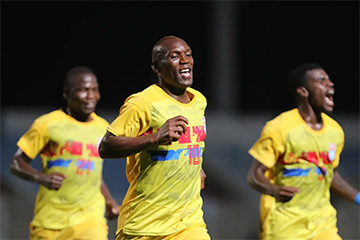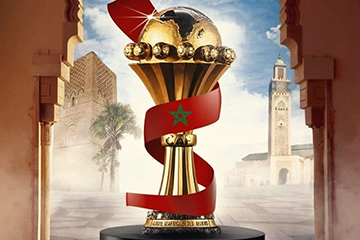AFCON
DILAPIDATED NATIONAL STADIUM, LAGOS CLOCKS 46
BY KUNLE SOLAJA.
The National Stadium in Lagos, once a pride to Nigeria, clocks 46 years this Tuesday from the date it was inaugurated by General Yakubu Gowon in 1972.
Now in complete state of repairs, the arena that hosted the 2nd All Africa Games and the 1980 Africa Cup of Nations as well as some of the matches, including the final of the 2000 edition has long seen its better days.
Yet it sits at the centre of the metropolitan Lagos mainland and remains a reference point in any discourse of how facilities and national monuments disintegrate in Nigeria.
The sports standard of a region is most times, a product of the facilities it offers. Hence, the level of success is linked with the amount of resources committed to sports.
Such resources are more visible in the magnitude of stadiums available. Brazil for instance, boasts of imposing stadiums like Maracana in Rio de Janeiro, Magalhaes Pinto in Balo Horizonte, Morunbi in Sao Paulo and Arrudao in Recife.
The trend is worldwide. The football strongholds of Europe and South America boast of magnificent sports edifices, which command attention in size and architecture.
Some of these great football grounds are time-honoured. Their histories date back to 1920s. Yet through maintenance and constant updating, they still meet the demands of present time
What is the situation at the Lagos National Stadium? In the bowels of the partly covered arena, the seats, which were fixed while the nation was crazy to host in 1995, what has become the FIFA U-20 World Cup, have become relics.
The electronic scoreboard merely stands as a huge black carcass atop the eastern semi-circular end. When Nigeria’s Flying Eagles hosted their Ethiopian counterparts at the stadium in one of the qualifying matches for the 1987 FIFA World Youth Championships, the Ethiopians described the National Stadium pitch as merely good for horse races. It has since gone from bad to worse as the initial lush green grass has gone from yellow to brown.

Relics of the scoreboard at the stadium
Even though the arena was opened on December 4, 1972 at a ceremony in which Nigeria beat Mali 3-0, its origin dates back to the 1951 when the site was acquired.
Then, the Nigeria National Stadium Board of Management had one Mr. C E Newham as chairman. The stadium was built in two stages. Phase one was a pre-fabricated timber terrace supported by scaffolding built in 1960 for the independence celebrations and the West African Games.

The remains of the once upon a time national pride
The arena was demolished in 1962 when a new design was adopted. Messrs Mence, Moore Mort Architects, prepared it. But work did not begin until the laying of foundation stone by Head of State, General Yakubu Gowon, on March 14, 1970.
Owing to the eight-year delay in the reconstruction of the arena, some of the materials designed for use in the works were not available during construction period.
Substitution had to be made. One of such was the use of twisted bars in place of tentor bars as high tensile steel reinforcement.
Also many products such as reinforced rods and electrical cables were only available in metric sizes as opposed to imperial units used in the design. Instead of proposed cinder track, synthetic materials were used.
Also, introducing intermediate support reduced the length of cantilever, the pillars supporting the roof at the covered stands from 23.77 metres to about 15.84 metres.
Messrs. Ove Arup and Partner Consulting Engineers carried out the engineering work of the project.
The consulting electrical engineers were Messrs Ademola Fowora and Associates. The project was that of Ministry of Labour.
In view of the fact that it was a major civil engineering project, Federal Government directed that the Federal Ministry of Works and Housing should carry supervision of the construction, so that the Director of Federal Public Works was the engineer for the project.
The contractors, Messrs. Cappa and D’Alberto took possession of the site in October 1969. After clearing the site of the temporary structures, the setting out for the frames of stands was carried out.
One problem area was the floodlights towers, which stand at 62.18 metres. There was the problem of reaching the top of the four towers by crane.
Then, the tallest crane in Lagos was 38.1 metres. Trial concrete mixes were carried out for the various types of concrete to be used for the construction works.
Suitable mixes were obtained and work progressed until there was shortage of steel reinforcement. Modifications were made and work ended early in January 1973 just in time for the 2nd All Africa Games, which acted as a catalyst for speeding up the beginning and completion of the project.
The result is a saucer-shaped main bowl. It is served by 12 ramps leading to main bowl and the stands have 72 exit points. The stadium could hold about 50,000 spectators. Two thousand of these occupied the standing terraces until the sections were phased out during the renovation of the stadium.
As part of preparations to host the World Youth Championship in 1995, the stadium’s concrete slabs were replaced with seats for individuals thus reducing the stadium’s capacity from 50,000 to 39,858.
The once glamorous arena no longer holds sports meets, but has turned into social hangout place and occasional used for religious gatherings and a haven for street urchins.
It last hosted the national football team on April 30, 2004 when a second tier Nigerian team lost 0-1 to Senegal in a trade-missioned LG sponsored competition.
AFCON
Liberia, Eswatini hold upper hand in AFCON 2025 preliminary qualifiers –

After commanding victories in the first leg matches of the Africa Cup of Nations, Morocco 2025, qualifiers, Chad, Liberia, and Eswatini find themselves in advantageous positions as they gear up for the return fixtures scheduled for Tuesday.
As the second leg of the preliminary fixtures approach, all eyes will be on these teams as they vie for their coveted spots in the group phase of the qualifiers, with the hopes of making their mark on the continental stage.
Chad emerged victorious with a narrow 1-0 win over Mauritius, joining Liberia and Eswatini in the lead after their impressive triumphs earlier last week.
Liberia secured a 2-0 victory against Djibouti, while Eswatini displayed their dominance with a 3-0 win over Somalia.
The second leg promises to be fiercely contested, particularly for Chad, who will face a challenging encounter against Mauritius on the latter’s home turf.
Coach Kevin Nicaise’s players are keen to defend their slender lead and secure their spot in the next phase of the qualifiers but the trainer admits they have an arduous task.
“We are far from perfect, far from being a top team in the world. We are in the construction phase. There are still things to work on and improve,” coach Nicaise said after their first-leg win.
“It is not overnight that we will be a top team in the world, we are aware of that, however we are working hard with the group and the staff to achieve this goal.”
Meanwhile, Liberia will host Djibouti, aiming to build on their first-leg success and seal their progression to the next round.
Eswatini will host Somalia with confidence, seeking to maintain their winning momentum and secure passage to the next stage of the tournament.
South Sudan and Sao Tome and Principe will also face off in what is expected to be a closely contested encounter, following their goalless draw in the first leg.
With both teams eager for victory, the match promises to be a thrilling battle for supremacy.
-CAF
AFCON
Liberia and Eswatini take control of AFCON preliminary ties

Liberia and Eswatini took commanding leads in their respective Africa Cup of Nations, Morocco 2025, preliminary round ties after claiming impressive away victories on Wednesday.
Liberia captain Murphy Dorley scored one of two first-half goals as the Lone Stars defeated hosts Djibouti 2-0 in the opening leg in Marrakech.
Mohammed Sangare broke the deadlock from the penalty spot on 23 minutes before Dorley coolly slotted home Sebastian Teclar’s cross 12 minutes later.
Djibouti struggled to lay a glove on their more illustrious opponents as the Lone Star side kept them at bay to take two away goals into next week’s second leg in Monrovia.
Eswatini were also celebrating after demolishing Somalia 3-0 in the Moroccoan city of El Jadida to put one foot in the group stage qualifiers.
Striker Sabelo Ndzinisa was the hero, netting twice either side of Felicio Figuareido’s 40th minute opener for the visitors.
Somalia now face an uphill battle to qualify when they travel to the Mbombela Stadium in the South African city of Nelspruit for the return on March 26th.
The opening leg victories give Liberia and Eswatini a huge advantage heading into the second legs as they target a place in the group stage on the road to next year’s finals in Morocco.
Back from the locker room, Somalia still couldn’t play its game.
Worse, Eswatini widened the gap with Ginindza who scored his double of the evening in the 56th minute. 3-0, the score remained unchanged on the scoreboard until the final whistle.
Victory for Eswatini which will still have to perform in the return leg to ensure its qualification for the qualifiers.
AFCON
Road to Morocco 2025 begins today

Following last month’s grand closing to the TotalEnergies CAF Africa Cup of Nations held in Cote d’Ivoire where the hosts were crowned champions for the third time, Africa’s biggest competition is now shifting its focus to the 35th edition set to be held in Morocco next year.
A total of 52 Nations will be engaged to compete for a place in the 24-nation competition.
To mark the start of the qualifiers following the draw that was held in Cairo on 20 February 2024, eight lowest ranked nations will compete in the Preliminary Qualifiers starting on Wednesday, 20 March over a two-legged format that will decide the four nations that will join the other 44 African nations to make up the group stages of the qualifiers.
The CAF AFCON Morocco 2025 journey officially gets underway on Wednesday, 20 March with two fixtures as Somalia plays host to Eswatini, while Djibouti faces Liberia.
Two days later, Chad locks horns with Mauritius before Sao Tome and Principe takes on South Sudan.
The return legs will conclude on Tuesday, 26 March with all matches set to take place on the day to officially decide the preliminary phase of the competition.
AFCON Morocco 2025 Preliminary Qualifiers:
First Leg Fixtures:
Wednesday, 20 March
- 18:00 GMT | Somalia – Eswatini
- 22:00 GMT | Djibouti – Liberia
Friday, 22 March
- 18:00 GMT | Chad – Mauritius
- 19:00 GMT | Sao Tome and Principe – South Sudan
Return Leg Fixtures:
Tuesday, 26 March
- 13:00 GMT | Eswatini – Somalia
- 16:00 GMT | Liberia – Djibouti
- 17:00 GMT | South Sudan – Sao Tome and Principe
- 15:00 GMT | Mauritius – Chad
-

 Olympics1 week ago
Olympics1 week agoSuper Falcons’ Paris 2024 fixtures recall Nigeria’s first matches at Olympic Games football event 56 years ago
-

 Nigerian Football6 days ago
Nigerian Football6 days agoRemo Stars add fuel to the fire as title chase turns East – West battle
-

 FUTSAL1 week ago
FUTSAL1 week agoDefending Champions, Morocco thrash Ghana to move to the summit of Group A
-

 UEFA Champions League6 days ago
UEFA Champions League6 days agoNigerians among Leverkusen’s African quintetin historic Bundesliga triumph
-

 Nigerian Football7 days ago
Nigerian Football7 days agoRangers tenaciously hold on at Nigeria League top position
-

 Bundesliga1 week ago
Bundesliga1 week agoNigeria’s Boniface is German champion with unbeaten Leverkusen
-

 Nigerian Football5 days ago
Nigerian Football5 days agoHeartland back to their homeland as they host Shooting Stars
-

 OBITUARY1 week ago
OBITUARY1 week agoAnother Germany World Cup winner dies




